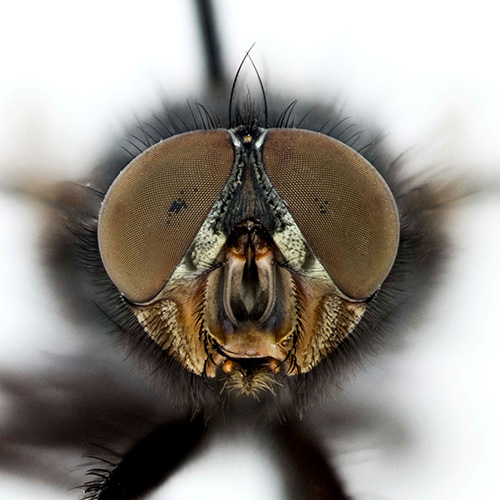IDENTIFICATION OF ARTHROPODS OF ECONOMIC AND HEALTH INTEREST
|
Description |

Entomological box from the UCME collection
The correct identification of arthropods is a complicated and laborious task, possible only when having the knowledge and tools that the specialists trained for that purpose possess. Nowadays it seems that, by searching on Google and seeing a photo, any kind of insect can be easily identified, but this is a big mistake and only the verification of a taxonomist offers us the guarantee of a correct identification, essential for any accurate scientific work.
|
How does it work |

Fly (Calliphora vicina)
The Arthropods’ Biology and Biodiversity (BBA) research group is constituted by a group of entomologists of proven scientific quality that works continuously in the taxonomy and systematics of Arthropods.
The current and mistaken idea that taxonomy is an obsolete and outdated discipline of Biology is very different to reality. The work of taxonomists covers much more than the simple identification of species, being the only experts in the organisms in which they specialize, as well as their main researchers. Therefore, our role is not exclusively to find the name of a certain animal collected under certain conditions, but also to provide information on their life cycles, their relationships with the ecosystem, possible influences on public health and practical applications of their relationships with others organisms and their environment.
|
Advantages |
Any enterprise that has unexpectedly encountered an arthropod in its facilities or products, either because of the place of occurrence or because of the damage it has caused, knows that it is very difficult to find a place where the specimen can be properly identified. We propose the solution from a public institution, lowering costs and ensuring work by the level of knowledge of our taxonomists, who are the ultimate reference point of the entomology of our Community.
|
Where has it been developed? |
Bee (Rhodanthidium sticticum) visiting a flower (Echium).
The BBA research group consists of 24 researchers who develop their research work in basic and applied studies in biodiversity, systematics, ethology and biogeography of arthropods, as well as the fauna associated with human activities, in order to contribute to conservation programs, the use of biodiversity and the environment at a national level and in the management of species of economic importance.
One of the most exclusive tools we have is the Entomological Collection (UCME), which is the result of the work of all the researchers who have passed through our facilities throughout our long history. With an estimate of three million samples, currently being digitalized, it serves as a basis for comparing specimens, which is essential when it comes to making a correct taxonomic identification.
|
And also: |
The BBA research group has experience collaborating with public and private companies in various topics related to applied entomology, in fields such as pollination and public health.
Besides, there are other lines of research, among which are:
• Pest control • Phylogeny of Arthropods
• Ecotoxicology • Arthropod palaeontology
• Larval states and life cycle • Ecology and biology of Hymenoptera
• Insect-Plant Interactions • Invasive species
• Public health pests • Edaphic fauna
• Teaching of natural sciences • Forensic wildlife
• Ethology of Arthropods • Urban fauna
|
Contact |
|
© Office for the Transfer of Research Results – UCM |
|
PDF Downloads |
|
Classification |
|
Responsible Researcher |
Concepción Ornosa Gallego: paddy@bio.ucm.es
Department: Biodiversity, Ecology and Evolution
Faculty: Biological Sciences


